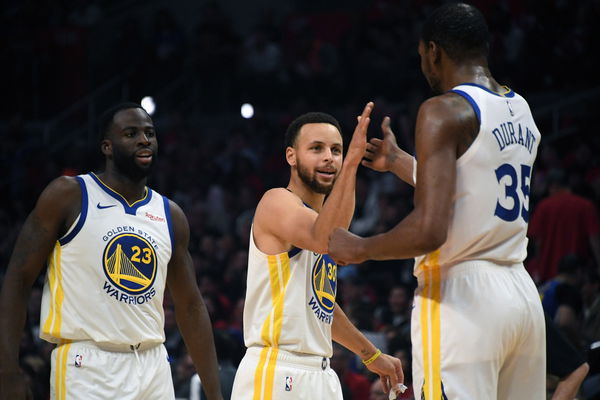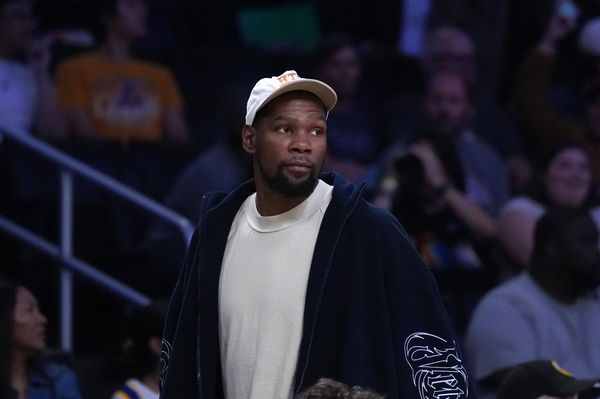
Imago
Credit: Imagn

Imago
Credit: Imagn
What’s a dream team if not basketball’s version of a love letter to the game? The kind that makes your heart race and your jaw drop. Think Stephen Curry pulling up from anywhere, Klay Thompson’s fire without the noise, Draymond Green’s chaos turned genius, and Iggy stitching it all together. Then came Kevin Durant, smooth as silk, fierce as fire. It felt unreal. Like someone hit pause on reality and play on a fantasy. For a moment, the Warriors made magic feel like routine.
Watch What’s Trending Now!
But even you know, this is a fact as true as the Sun rising from the East and setting in the West. Now, when Durant joined the Warriors in 2016, he was already an MVP with the Oklahoma City Thunder, back in 2014. As a natural 4, KD never really had to worry about switching positions or playing solely on his own. However, his perception of a forward and his gameplay took a drastic change in the Bay.
ADVERTISEMENT
Kevin Durant experienced a shift in his game after playing with Stephen Curry at the Golden State Warriors
The most interesting factor that makes the Dubs a legacy to rely on is how they altered the course of the NBA. Precisely with Steve Kerr as their head coach, he let Steph Curry and Klay redefine three-point shooting. And the rest has been history for them. In eight years, the franchise bagged four rings, which include a two-peat in 2017 and 2018. And most importantly, they rewrote an underdog story in 2022.
Now, coming back to Kevin Durant. He wanted more freedom to get on social media and be more vocal in OKC. But as Kendrick Perkins said, general manager Sam Presti was a team-first person, so he didn’t let things happen. And that brought KD to the Dubs. Appearing on Mind The Game, the Slim Reaper spoke about his experience as a Warrior. Was the transition easy for him? Moreover, how did he adapt to the classic split game action and adjust himself in the new system?
Responding to LeBron James’s question, the 36-year-old forward said, “It was pretty easy because up until—let’s say James got traded—so 2013 to 2016, I feel like those are the only years I was playing point forward in my whole life.” Durant was a player who combined the physical attributes and traditional role of a forward with the playmaking and ball-handling skills of a point guard. It was typical of him to pose a major threat to his rivals. “The rest of the time, I’m playing off my teammates. I might mix up a little, get off the rebound and push and play, but for the most part, I’ve been playing off my teammates up until that whole time period.”
ADVERTISEMENT

USA Today via Reuters
Apr 26, 2019; Los Angeles, CA, USA; Golden State Warriors forward Draymond Green (23) and guard Stephen Curry (30) and forward Kevin Durant (35) celebrate in the first half of game six of the first round of the 2019 NBA Playoffs against the LA Clippers at Staples Center. Mandatory Credit: Kirby Lee-USA TODAY Sports
He confessed: “So it was easy for me to come off a pin down. It’s hard for me to have to dribble through three or four guys and pull up over two dudes with a fadeaway. Like you said, we want to be efficient. Playing off your teammates, that’s the easiest way to be efficient.” Now, he also shared how one mantra from Steve Nash stuck with him when he moved to the Dubs.
ADVERTISEMENT
Durant admitted, “It’s always stuck in my mind that the defense knows if you’re going left, most of the time you’re going all the way to the cup. So that one- or two-dribble pull-up going left has been a staple for me.” The defenders always expected him to drive to the rim when going left. To counter that, he developed a ‘one- or two-dribble pull-up’ jumper on that side. It became a key move in his game and helped him stay efficient and less predictable.
The magic wasn’t just in the shot, but in how Kevin Durant picked up the ball. Going left, defenders knew his rhythm and swiped him clean. So, he rewired the move. He shifted his pickup point, changed angles, and fooled their timing. It wasn’t just skill—it was survival. Against physical defenses, every tweak mattered. He just wanted that clean look. Every time.
ADVERTISEMENT
Durant has to alter his muscle memory to fit further into the game
Kevin Durant opened up about one of basketball’s little secrets. “It was tough for me to go left sometimes and pull up for the jump shot.” In the early years, it nagged at him. But over time, he cracked the code. Through rhythm, reps, and range—from the paint to the NBA three—he discovered that “small detail” that made his game whole.
Steve Nash saw the duality. KD “preferred going left,” but funnily enough, “statistically, it’s good or better going right.” That tug-of-war between comfort and data intrigued Nash. He added, “Sometimes that’s because people know you want to go left,” pointing to habits over mechanics. For both, it wasn’t about right or wrong. It was about rhythm, feel, and evolving instincts under pressure.

Imago
May 27, 2025; Los Angeles, California, USA; Kevin Durant attends a WNBA game between the Atlanta Dream and LA Sparks at Crypto.com Arena. Mandatory Credit: Kirby Lee-Imagn Images
KD pushed the conversation deeper, asking, “Do you feel like you got more leverage in your body going left for some reason?” Nash’s story took a turn, raw and real. “I played limping around for six months,” he recalled from 10th grade. The ankle never healed right. So his game adjusted. “Pushing off my right became my de facto thing.” Sometimes, your strengths are born from pain, not design.
ADVERTISEMENT
Turns out, even basketball gods need rewiring. Kevin Durant found gold in the Bay, but also rewrote his own playbook—footwork, pickups, instincts, all reshaped by rhythm and reality. Playing with Curry sparked magic, but learning from Nash carved precision. What began as a chase for efficiency became a masterclass in evolution. In Golden State, KD didn’t just win rings—he reinvented flow.
ADVERTISEMENT
ADVERTISEMENT
ADVERTISEMENT

